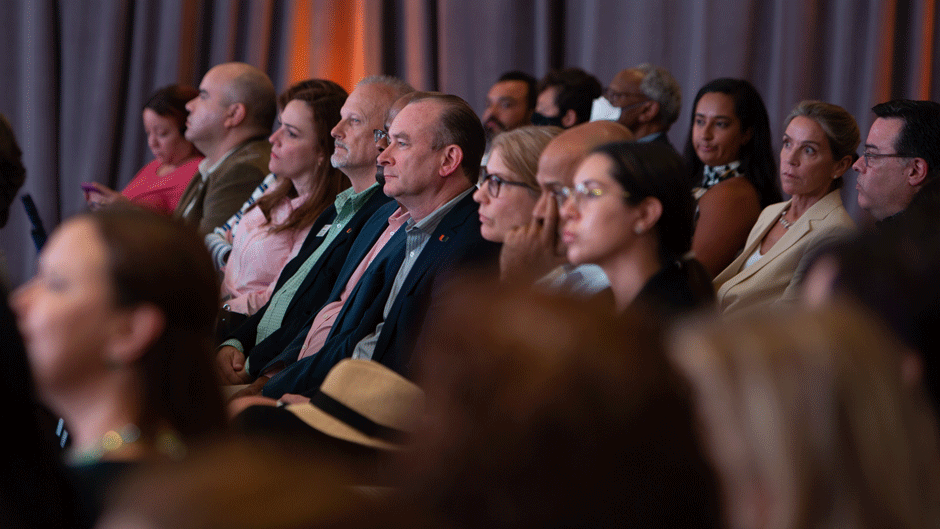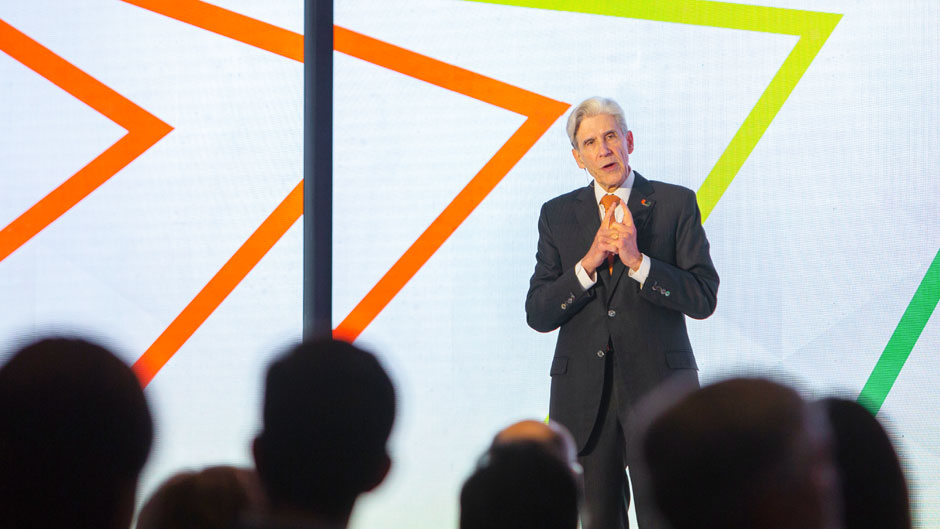With less than 1,000 days until the University of Miami marks its centennial, the institution remains on course to meet the objectives set as part of its ambitious strategic plan—the Roadmap to Our New Century, President Julio Frenk said Thursday during the State of the University Town Hall address.
Speaking to hundreds of attendees inside the Shalala Student Center Ballroom as well as an expanded audience watching virtually, Frenk said the institution not only intends to end its first century on a high note but also “to set a course for even greater achievements in our second century.” But doing so, he cautioned, will require bold decisions, hard work, and integrity.
“Bold decisions got us through the pandemic. When it comes to doing the right thing, this University is not afraid to be original,” Frenk said. He noted the decision to open classrooms for in-person learning during the fall of 2020. He also touted the institution’s success in convincing colleagues to hold athletic competitions and for its ability to find a way to serve patients whose well-being was threatened as much by hospital closures as it was by COVID-19.
Now, the University is leading by example in another way—by employing resilience to reframe its strategic plan, Frenk said.
“Resilience is a quality the U knows well,” the president explained. “Throughout our history, we have repeatedly overcome challenges by adapting to changing circumstances. Our strategy is no exception. If we are to reach our goals by 2025, the status quo will not suffice.”
The pandemic created dramatic disruptions and opportunities that are shaping each area of endeavor at the University, from education and research to health care, innovation, and athletics. Weathering those disruptions required laser-focused execution, which is why institution made a key strategic move, naming executive vice president for health affairs and CEO of UHealth Joe Echevarria as the University’s first chief executive officer, Frenk told the audience.
“The term CEO is not typically used in higher education. Some consider it taboo, bemoaning what they see as a corporatization of universities,” Frenk said. “Yet, if the charge of a position is to lead execution across the organization, then whatever critics may opine, the intellectually honest title is CEO.”
The move is viewed as helping to match the pace of change occurring in the operating environment of the University’s four pillars: the academic core, health care, intercollegiate athletics, and technological innovation.
During Frenk’s address, he highlighted those four pillars, describing them as distinct but interconnected aspects of the University.
“Success in one supports, enhances, and helps drive success in others,” he pointed out. “Our innovation in the classroom draws accomplished scholars. Our school spirit—driven by exciting wins in every field of competition—cements our passion for the U. Our life-changing discoveries in the lab give us the tools to improve health, to partner with visionaries, and to serve our communities.”
A series of four, two-minute video vignettes featuring students, faculty members, donors, and others augmented what the institution is accomplishing in its four pillars.
“What’s happening in the tech scene locally creates a context that can drive forward even greater innovation and ingenuity at our University,” Erin Kobetz, vice provost for research and scholarship, said in the video about the University’s technological innovation. “The emergence of tech in Miami helps us rethink what research and innovation can and should be. Our local multiculturalism and diversity necessitate that we pursue science and scholarship that matters.”
In the video clip on the academic core, Germane Barnes, assistant professor and director of the Community Housing and Identity Lab at the School of Architecture, said the University has nurtured him as a faculty member and served as a test bed for his research. “Not everything that I put into design is successful,” he said. “But being able to do those things and do them here makes the next opportunity that much better.”
The fact that the University is her “dream school” is an understatement, said theatre arts major Lexi Rosenbloom, a member of the Class of 2025, adding that the University of Miami allows students “to explore every single academic field.”
Noting the University is currently engaged in more than 50 projects addressing climate resiliency, Eric Levin, president of SeamLev Investments, said he wants the institution “to become a knowledge center around climate, to offer symposiums, to offer research, and to give solutions not only for the Miami community but regionally, nationally, and internationally as well.”

Meanwhile, the University’s health system treated more than 1.5 million patients last year, more than ever before, Dipen Parekh, chief operating officer of UHealth, pointed out in the video on the institution’s health care pillar. The health system, he said, is expanding access by adding more than 1 million square feet of new clinical research and educational space and is building a medical education facility and transformational cancer research building.
South Florida’s sense of pride is bolstered when University of Miami athletic teams win, said Vince Lago, mayor of Coral Gables, who was featured in the athletics video clip.
Miami’s athletics program has been riding a wave of emotion since last December when Mario Cristobal, who, as a Hurricanes offensive lineman helped the school’s storied football program win two national championships, returned to the University as football head coach. “ ’Canes football means everything to the community,” he said in the video. “It galvanizes Miami. It galvanizes our community and South Florida. And when South Florida comes together with the ’Canes, there’s nothing more powerful.”
Excellence and relevance in each of the four pillars requires a strong foundation, Frenk indicated. “There is no substitute for hard work. This means being deliberate not just about what we do, but about how we do it,” he stated. “In what we have dubbed Roadmap 2.0, how we carry out our mission underscores all of our pillars.”
Frenk drove home the fact that the University continues to be committed to building a culture of belonging. Stressing that diverse backgrounds, points of view, and life experiences have made the institution what it is today. “They make us a microcosm of the world we live in, and we have an opportunity to lead by example,” he said.
Geography does not restrict the University’s ability to assemble preeminent talent from far and wide to address pressing problems, Frenk maintained, noting that each year the institution attracts about 3,400 international students and hosts heads of state and business leaders from around the world. “We are a point of connection,” he said, “and we will leverage that to continue to drive excellence.”
Student Government President Jamie Williams-Smith opened the event, noting her administration’s connection to the University’s leadership and applauded the achievements of fellow students. Following the event, she shared additional thoughts.
“It was great to hear from President Frenk about the progress we’re making as we head toward our centennial year,” she said. “It felt like a really connecting moment to hear him talk about all the progress we’re making across all the campuses.”
Many other students attended the event at the Shalala Student Center to listen to Frenk’s remarks.
Karina Alegre, a senior from Miami who is studying communications, attended her first State of the U. “As a student, I always love hearing the word resilience after the pandemic that we’ve endured. I feel like President Frenk’s four pillars are tremendously beneficial to all students, especially the innovation in health aspect.”
Kofi Bame, a junior from Jacksonville studying psychology, said she was encouraged by the University’s approach that gives “students and faculty a chance to fail, which ultimately leads to success. There’s a lot more opportunity to grow if you fail first, and it’s great to feel that UM is somewhere where we can do that.”
University Communications writer Jenny Hudak contributed to this report.

